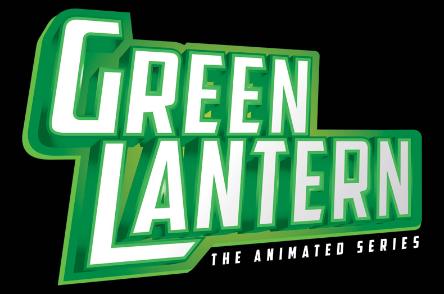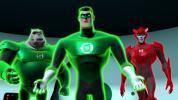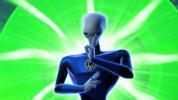
The World's Finest caught up with Green Lantern: The Animated Series Producer Giancarlo Volpe to discuss not only the series finale of the acclaimed animated series, based on the popular DC Comics character, but to also look back at the short life of this space-faring adventure. Volpe looks back at key moments from the series, the popularity of characters Razer and Aya, and the struggles with keeping key story-points secret. Green Lantern: The Animated Series airs Saturdays at 10:00am (ET/PT) as part of DC Nation on Cartoon Network! The series finale episode "Dark Matter" airs at 10:00am (ET/PT) on March 16th, 2013. Continue below for more. The World’s Finest: As the last episodes of Green Lantern: The Animated Series come to a close, and looking back, how plotted out was the series (for example, did you plant something in an early episode for the sole purpose of it paying off much later down the road, etc.) and were you happy with its execution? Giancarlo Volpe: Yeah, [Producer Jim Krieg] and I sat down and mapped out the broad strokes of the whole 26-episode arc before he even began writing the first script. We didn’t have it all figured out, but we knew the general direction it was headed. As more episodes were made, a lot of details ended up changing or getting moved, but for the most part the over-arching tale is intact and plays out how we originally planned. I’m really proud of how it all comes together, I just hope the fans like it too! There’s still a lot of plotlines that need to be revisited, though. For example, remember Galia, Kilowog’s love interest of the Zoar tribe? Whatever happened to her??
GV: It was already decided that the show would be done in CG before I even had my job interview. The theory was that it’d be a fresh angle on Bruce Timm’s style. You hear this term a lot in the business - “We want the same, but different.” The industry myth is that CG allows you to do anything, but it’s actually incredibly restrictive because everything ends up costing so much more. We had a very short list of characters and sets we could afford to build for season one. I was initially worried when I found this out, because I knew the show was going to involve a lot of travelling to different planets and meeting different alien species. We had to make compromises to make the whole thing doable. That’s why the Red Lantern Corps has generic foot soldiers, for example. It’s not that we didn’t want to put every unique Red Lantern in the show. It’s just that doing that would have broke the budget. I like to think that Dex-starr is inside one of those Red Lantern soldier suits. WF: When adapting a character from a different source material to an animated series – such as with Green Lantern here – just how in control is DC Comics and the network when it comes to what you can and cannot do and change? How much freedom do you have when working on an established property such as this? GV: For the most part, we were pretty proactive in trying to stay faithful to the comics. I’d imagine if we wanted to change things too drastically, DC would have stopped us. They reviewed every script, every animatic, and every locked picture. They were always understanding if we made minor changes, but there was a concerted effort to make sure we didn’t stray too far. For example, at first I assumed the Anti-Monitor was a giant robot. Adam Schlagman at DC had to remind me several times that he’s more of a “living entity” than a robot. I was thinking, “Oh crap, the censors aren’t going to be too pleased when he gets his head ripped off.” We took out any lines that describe him as a robot, but let Standards and Practices go on believing he was. WF: How beneficial was the use of CG animation when it came to animating the ring constructs? What kind of advantages did CG bring over standard 2D animation when it came to the constructs, and just how complex was it having to create these constructs in three-dimensional space? GV: The hardest part was figuring out how the constructs come out of the rings and go back into them. If you step through the animation, you’ll see it’s kind of a combination of scaling the object up and fading it on screen, which isn’t much different than how we’d do it in traditional animation. We had a very limited amount of props we could build for the series as well, so I was extra stingy about putting constructs in the first 13 episodes of the show. Then someone pointed out that we were way under our prop count bid, which is why you see a significant spike in constructs in the Guy Gardner episode and beyond. WF: This might be an odd question, but at what resolution were these shows produced (720p or 1080p) and how is something like that taken into account when creating these episodes? GV: Now you’re talking technical stuff that is barely beyond my grasp of comprehension. I believe it’s 1080p. I think what your asking is, “Was the show made it HD?” and the answer is absolutely. We reviewed all the animation on a big screen HDTV. It bums me out that the DVD’s are not Blu-ray. I hope this changes soon. WF: Did you expect for fans to latch on to Razer and Aya as they did during the show’s run? What do you think these two character represent and why did they resonate so much with the fans?
I think Razer and Aya’s involvement in the show also really drew in a huge female demographic, which is usually not common in action-super hero shows. I was proud that they related to Aya so much, and developed crushes on Razer. Believe me, had I known in the early stages that Aya would have been so well received, I’m not sure we would have planned to turn her into a bad guy. WF: With the internet, TV guides, and spoiler sites, it was very difficult for certain surprises to remain as such during Green Lantern: The Animated Series’ run. Why do you think it was so important to keep some of the show’s plot twists and surprises a secret? A did some of these slipping out ruin the impact for some of these events, in your opinion? GV:It’s the one thing that really makes me rage vomit. Storytelling requires coming up with twists and turns and revealing them in very specific order so that the journey has a maximum effect on your emotions. If you’re anticipating certain things to happen because of spoilers, it’s not going to hit you as hard. They were making the end product not as impactful as it should have been for a lot of fans. It really drives me nuts. That having been said, it may have been better that some viewers knew Aya’s death was coming, because they might have gone into cardiac arrest if that scene transpired without warning. Who knows, maybe the spoilers actually saved a lot of people’s lives. WF: Looking back on all 26 episodes, is there one moment in particular that you’d like to single out as “the” moment from Green Lantern: The Animated Series and explain why that is? GV: There’s a few. I think when the planet blew up and took Shyir Rev with it, it made a firm statement that this is not your average kid’s show. And I loved that we got that in so early in the series. I loved how much the fans latched on to that subtle flirty scene in the Betrassus episode where Aya tells Razer he also looks fine. I think that was Jim’s idea. Bruce and I actually stretched out the awkward pause in editorial to make it even more tense.
That having been said, I think killing Aya and turning her evil was perhaps the biggest risk we took. Up until that moment, the storytelling on this show was actually quite “safe”. That was the most controversial call we’ve made. I think it broke a lot of people’s hearts, but it also seemed to get a lot of attention from the hardcore fan sites. It’s like if anyone had doubt that this show took itself seriously, that pushed a lot of people over the edge in our favor. Even despite causing a lot of fans to get mad at us. WF: Are there any unsung heroes of Green Lantern: The Animated Series, either on the screen or behind it, that you’d like to acknowledge? GV: Well, on the screen, it’s clearly LANOS. It’s hard to single out any one person on the crew, because all of them were so key in making the series what it is. Sam Liu and Rick Morales are incredible directors, and we were lucky to have them aboard. I think I’ve sung praises for our composer Freddie Wiedmann countless times, but I’ll do it again. He really brought an added layer of weight to everything with his score. The show would not have been the same without his contributions. I also want to really recognize our overseas studio, CGCG. I had worked with them on Star Wars: The Clone Wars, and I knew they were capable of doing stellar work. I really wanted dynamic fight scenes balanced with very subtle facial expressions on this show, and they executed that direction incredibly. I’m not sure any average animation studio could pull of what they did. I also think Porto’s bakery in Burbank deserves a shout out because they make really good chicken sandwiches. WF: Ultimately, what is the one thing above all else that you hope viewers will take away from Green Lantern: The Animated Series overall? GV: To me, the whole point of superhero stories is to inspire you to be a better person. Superheroes set an incredibly high bar of “doing good” that we should all aspire to. Also, I wanted people to believe that the “good” emotions – hope, compassion, and love will always ultimately triumph over the “bad”- hate, fear, and greed. These were the very basic themes that we borrowed from the comics that I wanted people to take away from the show. I also wanted to prove that a superhero show could appeal to more than just 6-11 year old boys. I love that a lot of fans say they watch the show with their girlfriends, their parents, their kids, etc. It’s a very high compliment. WF: Any final thoughts on Green Lantern: The Animated Series? And where can we expect to see your work next?
As far as my future - at the time of this interview, I’ve worked on two projects since we wrapped episode 26 – neither of which I can announce publicly. I’m still at Warner Bros. Animation, so there’s a good chance a least one of them takes place in the DC universe. The other is very bizarre and like nothing I’ve ever done before. I hope that all the amazing fans, especially the ones I’ve met on Twitter and Tumblr will come out to support whatever my next project happens to be. Unless it’s not very good. But if that’s the case, I’ll warn you ahead of time. "Green Lantern: The Animated Series" airs Saturdays at 10:00am (ET/PT) as part of DC Nation on Cartoon Network! The series finale episode "Dark Matter" airs at 10:00am (ET/PT) on March 16th, 2013. |



